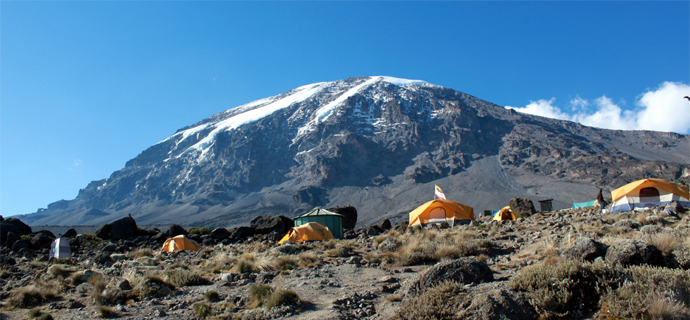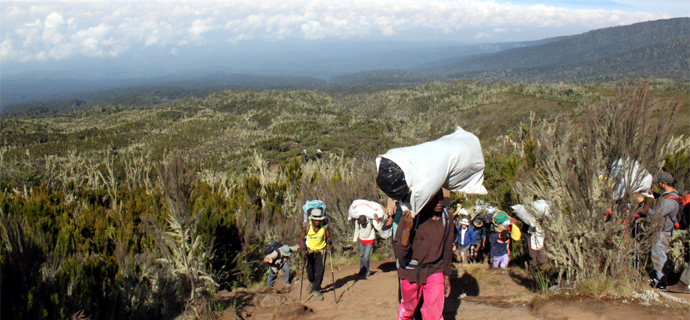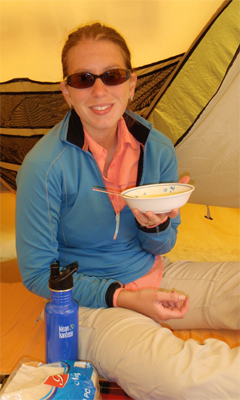
Mount Kilimanjaro Climb Overview
I had never climbed a mountain before we set off for Africa to climb Kilimanjaro. My wife had been on a climbing trip in Colorado as a leader with Young Life after college and really enjoyed the experience. When considering vacation options, she suggested going to a mountain and I decided that if we were going to climb something, we might as well make it something that counts. Climbing one of the seven summits is just one of those achievements that tend to stand out and getting to travel to Africa and experience a very different culture was also very compelling. It took some time for Debbie to come around to the idea but she eventually agreed as long as our next vacation involved relaxing on a beach.
Committing to this particular adventure was just the beginning and we spent close to eight months researching trekking companies, getting vaccinations, selecting our gear and training for the climb. We knew that this was really a once in a lifetime vacation and wanted to get everything just right.

Choosing a Kilimanjaro Trekking Company
The first and most important decision we faced involved selecting the route we would take up Mount Kilimanjaro and the trekking company that we would trust to lead us. There are six sanctioned routes of the mountain and we selected the Machame or Whiskey route and opted for the extra acclimation day for a total of 7 days on the mountain. We chose this route over the more popular Marangu (Coca-Cola) route for several reasons. First, the longer route seemed to offer a better chance of a successful climb because of extra days to adjust to the altitude. Also, reading about the Marangu route made it seem a little crowded and sleeping in huts instead of tents didn’t seem like as authentic an experience to us.
The Kilimanjaro trekking company choices are numerous and prices can vary wildly. It can be a little overwhelming to start sorting through them but this decision probably has the most impact on your overall experience. There are a few things we took into consideration when selecting our Kilimanjaro trekking company. We knew we also wanted to go on safari after the climb and it seemed to make sense from a financial and logistical standpoint to go with a single company that could offer a package on both. Ideally, we wanted a company that offered the option of adding a pulse oximeter and emergency oxygen for added safety. The company that we ultimately settled on was Good Earth tours. They had the added benefit of a US office. Though it was probably just a single guy in a home office, it made communication and payment much easier. Not all trekking companies are known for treating the porters and guides fairly so it’s important to find a company that it socially responsible.
Kilimanjaro Vaccinations & Medication
After we had locked in our travel plans, we had to make sure our vaccinations were up to date. Since some of the vaccinations required a series of shots, it was important to start early. We had been pretty lax in keeping current with our vaccinations once out of school but our primary care physicians were able to administer the Polio, Hepatitis A, Hepatitis B, MMR and DPT inoculations. They also prescribed Malarone malaria medication, Acetazolamide for altitude sickness and a course of Cipro antibiotics just in case.
There were some decisions we had to make about the medication. There were two anti-malarial options – Malarone and Lariam. One of the side effects of Malarone was increased skin sensitivity to sun light which isn’t ideal when spending hours a day at altitude under the hot African sun. The side effects of Lariam seemed more serious including potential psychiatric issues including hallucinations so we decided to move forward with the Malarone. Acetazolamide (Diamox) was the altitude medication of choice but the doctors had differing opinions on the appropriate dosage. After completing the climb, the 125mg dosage seemed a better fit and the higher dosage pills caused some stomach issues. Finally, we didn’t run into any issues with the antibiotic but the Cipro family of antibiotics has been associated with increased occurrence of tendon tears and ruptures. As an active individual who spends a good deal of time running, I would steer clear of Cipro.
There were some vaccinations that are too specific for general practitioners to carry. We had to go to a travel doctor for the administration of the Yellow Fever and Typhoid vaccines. These shots were quite a bit more expensive than we expected and between the two of us the total came in at around $700. Some people recommended a rabies vaccination as well but our travel doctor didn’t administer a preventative rabies vaccine so we didn’t pursue it further.
Travel Insurance
There was obviously quite a bit of an investment in this trip to Africa so we considered several travel insurance options. Since the flights, climb and safari were non-refundable the biggest concern was that something would come up that would prevent us from departing as scheduled. Unfortunately, the insurance pricing was dependant on the trip costs which made the travel insurance a significant expense in itself. We ultimately decided against purchasing travel insurance since it would have been a couple hundred dollars spent on something that we knew we probably wouldn’t need to use. It was also difficult to tell what travel insurance companies were reputable and reliable. At the end of the day, your decision here just depends on your risk tolerance.
Kilimanjaro Flights
At the end of the day, flights are going to be long and expensive. We chose to fly straight into Kilimanjaro Airport for simplicity and efficiency. We could have saved a little money flying into Nairobi and taking a six hour bus ride but that seemed like a rough way to start the journey. The trip to Tanzania does require a visa. The application process involved sending our passports along with the application and photos to the Tanzanian embassy. It was a little nerve-racking mailing such critical documents just before the trap. If your safari will be taking you into any Kenyan parks, you may need multiple entry visas but we stayed exclusively in Tanzania.
Though all our gear was important, we were intentional in making sure anything we couldn’t live without stayed with us. We wore our hiking boots and pack critical climbing supplies in our hiking backpacks which brought as our carry on luggage. During the trip we were also intentional about staying hydrated so that we would be able to start the Kilimanjaro climb off strong.
Our flight took us from Chicago to Amsterdam’s Schiphol airport for a brief layover before we continued on to Kilimanjaro International. The airport itself was nice enough but security seemed quite strict. On the plane, the personal video screens featured a great movie selection, games and even some language training programs that made the time pass faster. When we arrived at the small airport, we were excited to collected our luggage and connect with the team from Good Earth Tours. They took us to the hotel in Arusha where we did our best to rest up before beginning the Kilimanjaro climb.
Tanzania Currency
We decided against bringing traveler's checks on the trip. We knew much of the trip would be in areas where there wouldn't be easy ways of exchanging them. Since we needed to have enough on hand to tip our team at the end of the Kilimanjaro climb, it meant carrying more cash than I would have liked. Early on, I wore a money belt and kept the cash with me always but eventually, the cash ended up riding along in my pack. Between the Kilimanjaro climb and the start of the safari, we were able to stop at aan ATM in Arusha to get more cash. There are a couple important things to note about cash in Tanzania. First, US currency is readily accepted but only bills dated after the year 2000 are seen as valid. Since counterfeit bills are an issue worldwide, there is more confidence in the newer bills. The second important thing to realize is that outside the country the local currency, Tanzanian Shillings, are pretty useless. We tried to exchange our extra cash in Amsterdam and again in Chicago without success. Because of the volatility of many of the African currency, most currency exchanges will only accept Kenyan Shillings or South African Rand. If you don't want to be stuck with some extra souvenirs, make sure to cash out local currency before leaving the country.

Kilimanjaro Food
Going into the climb, we didn’t know what to expect for meals. Good Earth reassured us that the food would be familiar but didn’t get into specifics. Part way into the first day of the climb, we were given a boxed lunch with some fried chicken, a juice box, fruit and cookies and chocolate. The chicken was pretty dry but everything tasted excellent. We would run into this type of boxed lunch pretty frequently throughout our time in Tanzania.
When we arrived at the first camp, we were greeted with a popcorn and cookie snack. We also were given hot water and a variety of teas, hot chocolates. A separate meal tent was set up for our dinner and our assistant guide brought us a vegetable soup. We ate a couple helpings of the soup, assuming it was all there was but then a main course was brought in followed by dessert. We learned to pace ourselves better after that.
It was really impressive what our cook could put together on the climb. Everything was delicious and familiar as promised – soups, pastas, rice, chicken, fish and more. Halfway into the climb, we were served watermelon and couldn’t help but wonder who was stuck carrying that the entire time. Without refrigeration, we wondered how some of this food was being transported but we decided not to question it.
At higher altitude, our appetite began to diminish a bit but we were never disappointed with the food itself. During the rigorous climb, it was good be able to rely on a good source of food. After seven days on the mountain, it was still a treat order a pizza at the hotel restaurant.
|
